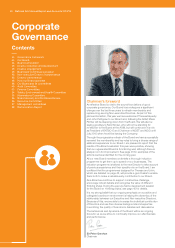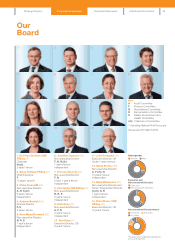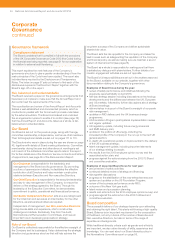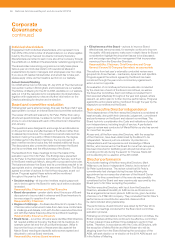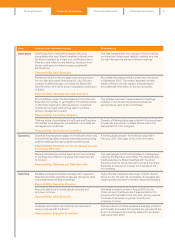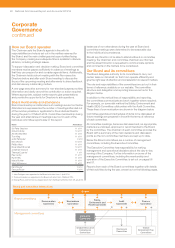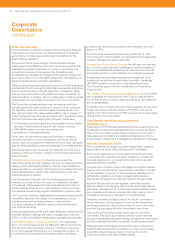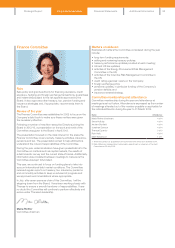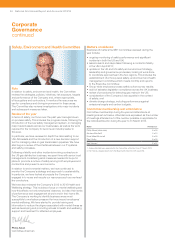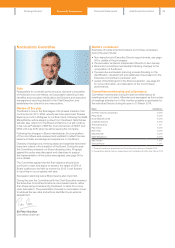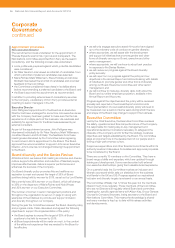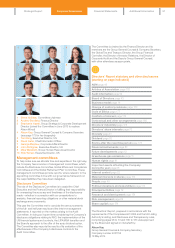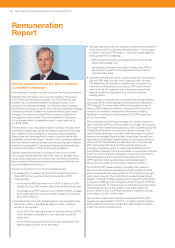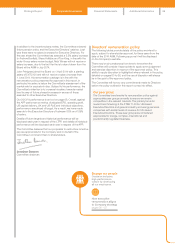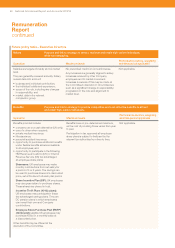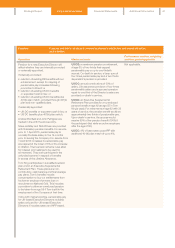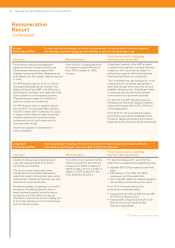National Grid 2014 Annual Report Download - page 54
Download and view the complete annual report
Please find page 54 of the 2014 National Grid annual report below. You can navigate through the pages in the report by either clicking on the pages listed below, or by using the keyword search tool below to find specific information within the annual report.
Corporate
Governance
continued
Audit information
Having made the requisite enquiries, so far as the Directors in
office at the date of the approval of this report are aware, there is
no relevant audit information of which the auditors are unaware
and each Director has taken all reasonable steps to make
themselves aware of any relevant audit information and to
establish that the auditors are aware of that information.
Internal control, risk and compliance
We regularly consider the effectiveness of financial reporting,
internal controls and compliance with applicable legal and internal
requirements. We also review the procedures for the identification,
assessment, mitigation and reporting of risks.
To continuously improve and remain at best practice levels, the
risk management team reviews risk process standards, emerging
trends and concepts being driven by the main consultancy firms
and seeks to apply these as appropriate. The standards issued by
the Committee of Sponsoring Organizations of the Treadway
Commission (COSO) and the international risk standard ISO 31000
continue to inform the principles of our risk management process.
Specific improvements delivered during the year, and ongoing,
were noted by the Committee at its meeting in September. These
improvements include an enhanced approach for risk reporting
tothe Executive Committee, focusing on giving better visibility
ofmitigations and their impact on how risks are scored.
The scope of risk discussions has also been widened to
incorporate specific consideration of our treatment of and
preparedness for emerging risks (uncertainties on the horizon
thatare still developing and so may or may not evolve into threats
or opportunities for us) and potential ‘black swan’ type events
(catastrophic events of extremely high impact and extremely
lowlikelihood).
The Board has participated in an interactive risk workshop to
reinforce awareness of our key risks so its views can be captured
and incorporated into our risk management activities. The output
of this session formed part of the risk information reviewed at the
March Audit Committee meeting.
Details of our internal control and risk management systems,
including over the financial reporting process can be found on
pages 22 and 25 and page 170. Our risk factors are described
infullon pages 167 to 169.
Compliance management
The Global Ethics and Compliance team has continued to focus
on promoting improved consistency of reporting on control
frameworks across the compliance reporting process. The aim
ofthis activity is to make sure any problem areas are transparent
and that all parts of the business are applying a similar standard.
The Committee asked for a review of the key compliance areas
that are subject to the reporting process. Currently, reporting
focuses on legal compliance obligations only, and consideration
isbeing given to whether all key areas are covered and what, if
any, other areas should be included. The Committee also received
the annual reports on the Company’s anti-bribery procedures and
whistleblowing procedures and reviewed their adequacy. It noted
that no material instances of non-compliance had been identified.
Going concern
Having made enquiries and reviewed management’s
assessment of the going concern assumption, the Directors
have a reasonable expectation that the Group has adequate
resources to continue in operational existence for the next
financial year and the foreseeable future. For this reason, the
Directors are satisfied that, at the time of approving the financial
statements, it is appropriate to continue to adopt the going
concern basis in preparing the consolidated and individual
financial statements of the Company.
Management’s assessment process
In accordance with the draft recommendations of the updated
Financial Reporting Council guidance on going concern and
liquidity risk, we have reviewed and amended our going
concern assessment process.
Our process is an extension of our business planning process,
and is further supplemented by our annual budget and other
liquidity risk management controls. Our five year business plan
and one year budget were reviewed and approved by the
Board at its meetings in September 2013 and March 2014
respectively. The Finance Committee provides ongoing
oversight of our liquidity policy, which requires us to maintain
sufficient liquidity for a rolling 12 month period.
In light of our refreshed approach, we have reconsidered what
the most appropriate ‘foreseeable future’ period is. Given our
business model, current regulatory clarity and other factors
affecting our operating environment, and the robustness of
ourbusiness planning process and scenario analysis, we have
concluded the foreseeable future period is the five years ending
31 March 2018, in line with our business plan. This period is
considered to be the ‘foreseeable future’ as required for this
going concern assessment only, and is in accordance with
company law, accounting standards and the Listing Rules. We
will reassess this period annually in light of developments in our
operating environment, business model and strategic priorities.
Our business plan considers the significant solvency and
liquidity risks involved in delivering our business model in light
of our strategic priorities. The business plan models a number
of upside and downside scenarios, derived from the risks and
opportunities identified, and determines the impact these
would have on our results and financial position over the five
year period. In addition, we have reviewed and challenged a
number of worst case scenarios and their possible remediation.
Our business model calls for significant capital investment to
maintain and expand our network infrastructure. To deliver this,
our business plan highlights that we will need to access capital
markets to raise additional funds from time to time. We have
along and successful history in this regard; however, our
business plan also models various KPIs used by lenders
andcredit rating agencies in assessing a company’s credit
worthiness. These models indicate that we should continue
tohave access to capital markets at commercially acceptable
interest rates throughout the five year period. To monitor and
control risks around access to capital markets we have policies
and procedures in place to help mitigate, as far as possible, any
risk of a change in our credit ratings and other credit metrics.
More detail on our financial risks, including liquidity and
solvency, is provided in note 30 to the consolidated financial
statements. There have been no major changes to the Group’s
significant liquidity and solvency risks in the year.
52 National Grid Annual Report and Accounts 2013/14


